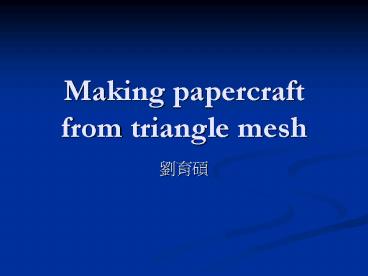Making papercraft from triangle mesh - PowerPoint PPT Presentation
1 / 16
Title:
Making papercraft from triangle mesh
Description:
Only consider conic surface, not general developable surface. Use single conic surface to approximate each chart, lose the potential of forming larger charts ... – PowerPoint PPT presentation
Number of Views:180
Avg rating:3.0/5.0
Title: Making papercraft from triangle mesh
1
Making papercraft from triangle mesh
- ???
2
Outline
- Problem statement
- Background
- Related work
- My research direction
3
Problem
- Papercraft
- Unfold a model (triangle meshes) onto pieces of
paper - Reconstruct the model from paper, by cutting and
gluing - The only unfoldable surface is developable
surface - General models need segmentation or cutting to be
reasonably unfolded
4
Background parameterization
- Preserve
- Angle
- Area
- Distortion can be measured using the two singular
value Gand ?of Jacobian matrix - Gand ? represent the largest and smallest length
when mapping the unit length from texture domain
to surface - Distortion always exist except for developable
surfaces
5
Characteristic of paper
- Paper is developable surface
- Gaussian curvature equals zero
- Can be unfolded without any distortion
6
Related work - papercraft
- Making Papercraft Toys from Meshes using
Strip-based Approximate Unfolding. Siggraph 2004 - D-Charts Quasi-Developable Mesh Segmentation.
Eurographics 2005 - Paper Craft Models from Meshes. Pacific
graphics 2006
7
Making Papercraft Toys from Meshes using
Strip-based Approximate Unfolding
8
Making Papercraft Toys from Meshes using
Strip-based Approximate Unfolding
- Segment the model into several charts then cut
the charts into triangle strips - Not convenient for cutting and gluing
9
D-Charts Quasi-Developable Mesh Segmentation
10
Paper Craft Models from Meshes
11
D-Charts Quasi-Developable Mesh Segmentation
12
- Framework
- Region growing
- Use conic surface approximation of developable
surface as error metric - Optimize the conic surface at each iteration
- Conic surface is a subset of developable surface
- There exist an axis s.t. the angle between the
axis and normal of every point on the surface is
constant
13
Problems of current method
- Only consider conic surface, not general
developable surface - Use single conic surface to approximate each
chart, lose the potential of forming larger
charts - Not consider cutting explicitly, lose the
potential of forming larger charts
14
Related work cutting
- Spanning Tree Seams for Reducing
Parameterization Distortion of Triangulated
Surfaces. IEEE Proceedings of Shape Modeling
International 2002
15
Spanning Tree Seams for Reducing Parameterization
Distortion of Triangulated Surfaces
16
Research direction
- Find more general error metric for developable
surface - Consider multiple developable surface
approximation of original surface - Consider cutting
- Smooth and short cut
- Feature preserving
- Developable NURB surface

